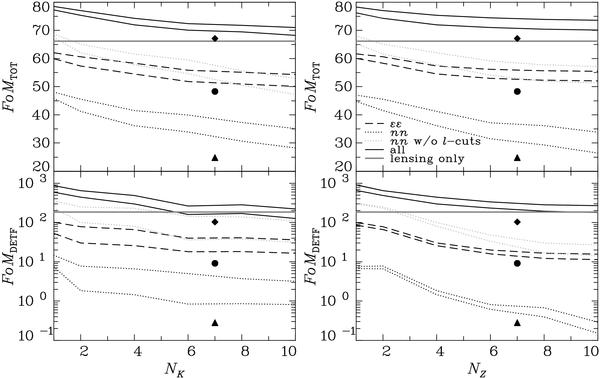Fig. 2

Left panels: figures of merit as a function of the number of free parameters as a function of wave vector NK in the bias terms For each line type, the upper curve is obtained for a number of free bias parameters as a function of redshift NZ = 2, the lower is for NZ = 4. Right panels: same as on the left, but as a function of NZ, i.e. the number of redshift parameters in the bias terms. The upper curves for each set correspond now to NK = 2 and the lower ones to NK = 4, respectively. Upper panels: figure of merit taking into account the full cosmological parameter space, FoMTOT, see (45). Lower panels: dark energy figure of merit from the Dark Energy Task Force FoMDETF, see (44). Dashed curves correspond to results using galaxy ellipticity correlations (ϵϵ) only, dotted black curves to galaxy number density correlations (nn) only, and solid black curves to results using all correlations (ϵϵ, nn and ϵn). The grey dotted lines show results for nn correlations without imposing cuts in angular frequency. The constant grey line marks the FoM computed for the pure lensing, i.e. GG, signal, assuming intrinsic alignments do not exist. In addition we show the resulting figures of merit when using our most flexible parametrisation with NK = NZ = 7 as filled symbols. Circles correspond to ϵϵ, triangles to nn, and diamonds to all correlations.
Current usage metrics show cumulative count of Article Views (full-text article views including HTML views, PDF and ePub downloads, according to the available data) and Abstracts Views on Vision4Press platform.
Data correspond to usage on the plateform after 2015. The current usage metrics is available 48-96 hours after online publication and is updated daily on week days.
Initial download of the metrics may take a while.


